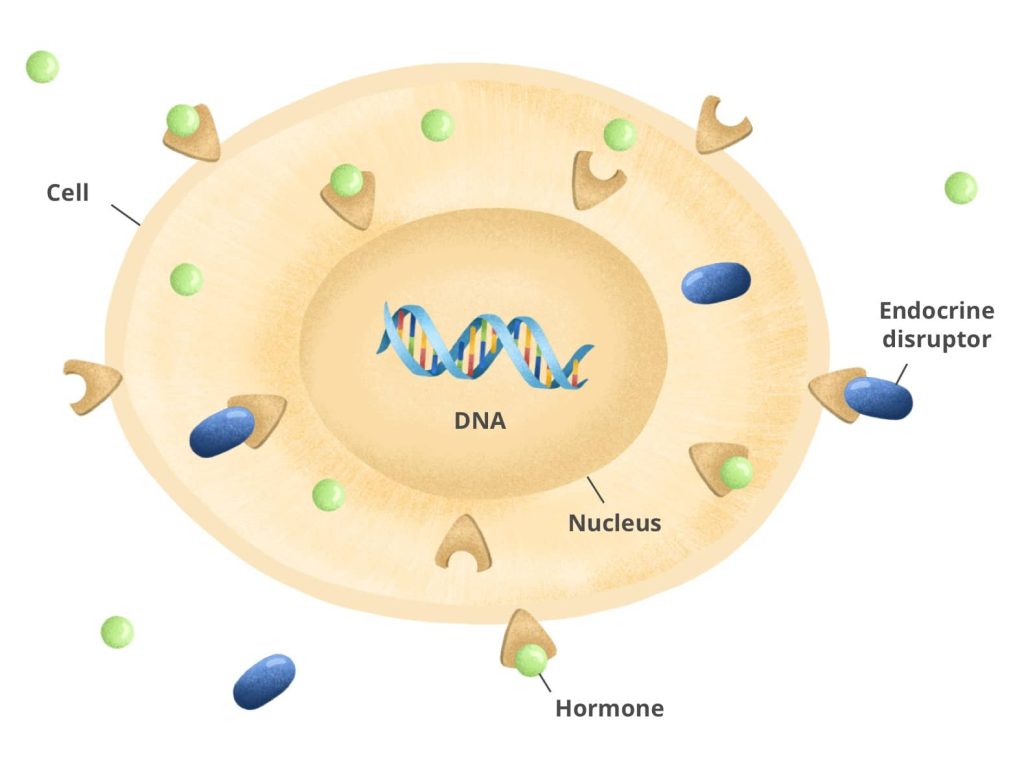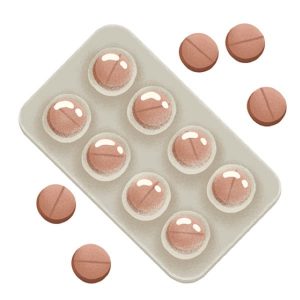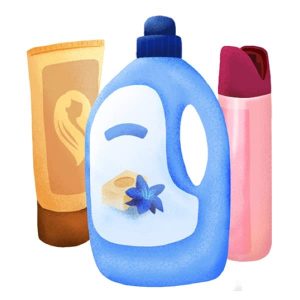
Over the course of the 20th century, the chemical industry developed more than 100,000 molecules1. Today, 40,000 to 60,000 manufactured chemical products are sold throughout the world2. Many among them are known or suspected to be endocrine disruptors.
While endocrine disruptors have been all over the media in recent years, they are also in our everyday life. They can be found in our food, our clothes, our furniture, even in the water we drink and the air that we breathe. But what are they exactly? Why are they so bad, and what solutions are there to avoid them?
Researcher and biologist Jean-Baptiste Fini, endocrine disruptor specialist, is here to help us get to the bottom of it.
What are endocrine disruptors?
According to the World Health Organization’s (WHO) definition, an endocrine disruptor is “an exogenous substance or mixture that alters function(s) of the endocrine system and consequently causes adverse health effects in an intact organism, or its progeny, or (sub) populations”³.
To understand how endocrine disruptors work, we first need to understand how hormones function. In a normal situation, our body secretes hormones which work as chemical messengers. The hormones allow our organs to communicate with each other in order to produce different reactions. Our brain acts as the conductor for the fifty or so hormones that we create.
These hormones support organ development and control long term processes of growth, reproduction, and development. They are also key players in our physiology because they regulate our appetite, temperature, sleep, and even our mood.
The problem with endocrine disruptors is that they interfere with our natural hormonal functions. They will do so in three ways :
- They can change our natural hormone production by interfering with their mechanisms for synthesis, transport, biodegradation, or elimination.
- They can mimic the actions of our natural hormones by taking their place, which causes problems when those specific hormonal functions are unnecessary.
- They can block hormone function by taking their place on receptors.

Through these different interferences, the endocrine disruptors also impact essential body functions like metabolism, reproductive health, and even nervous system functions. This leads to consequences that we will examine later in this article.
Where are they?
Endocrine disruptors tend to hide in plain sight, and we are exposed to them all the time in our daily environments.
 | Food & water |
- The presence of certain pesticides in our foods, especially in fruits and vegetables, contributes heavily to our exposure to endocrine disruptors. Out of the 90 pesticides that the European Food Safety Authority has reassessed since 2018, 10 were identified as endocrine disruptors.
- Certain food additives like BHA (E320) or BHT (E321) are among those suspected to have endocrine disrupting effects4-7.
- Tap water can also contain endocrine disruptors because of its contamination by pesticides or pharmaceutical products (specifically contraceptives).
 | Food packaging & kitchen utensils |
- Endocrine disruptors are in certain plastic wraps and containers. Phthalates, for example, can migrate into food, especially when heated8.
- Certain paper and cardboard packaging can contain perfluorinated compounds (for example, pizza boxes or microwavable popcorn packets) which work as endocrine disruptors. This packaging can produce mineral oils from its ink and adhesives which can affect endocrine disruption. These can migrate into food9,10.
- Non-stick cooking tools can also contain harmful substances, notably perfluorinated compounds (PFOA, PFOS) which act as endocrine disruptors.
 | Medicines |
- Certain drugs can have effects on endocrines11.
- By definition contraceptives, such as “the pill”, are endocrine disruptors because of how they alter hormone function by preventing ovulation.
- Drugs are designed to help take care of our bodies. The issue at hand is less about evaluating health benefits or risks, and more about their potential environmental impact (see below).
 | Cleaning & hygiene products |
- Many cleaning products contain substances that are recognized or suspected endocrine disruptors. Examples include preservatives or texturing agents (triclosan, phthalates, or certain parabens).
- Similarly, these substances appear in beauty and hygiene products (deodorants, shampoos, makeup, toothpastes, etc.).
 | Home & furniture |
- Quite a few household products and furniture contribute to indoor air pollution, mostly because they contain brominated flame retardants – substances which are designed to reduce flammability – some of which have been identified as endocrine disruptors.
- Fabric products (drapes, carpet, bedding, etc.) contain these flame retardant or stain resistant substances (perfluorinated compounds), some of which are potential endocrine disruptors.
- Furniture can emit different problematic substances, like formaldehyde. Notably furniture made from particleboard which contains an endocrine disrupting glue.
- Paint can also contain potential endocrine disruptors.
In 2019, a study by the French Public Health Agency (Santé Publique France) revealed that proven or suspected endocrine disruptors were present in the bodies of all French people, with higher rates among children. Amongst the French population, 6 families of disruptors were found: bisphenols, parabens, glycol ethers, brominated flame retardants, and perfluorinated compounds. According to the French Public Health Agency, the degree of impact measured was comparable to those of other studies conducted in the United States and Canada12.
What are the effects?
The proven or suspected effects of endocrine disruptors are numerous, impacting both human and environmental health.
Human health impact
A 2021 study conducted by the French Public Health Agency (Santé Publique France) identified more than fifty health effects which were attributed to endocrine disruptors17. According to current data, the main endocrine disrupting effects are the following:
1. Reproductive effects
Endocrine disruptors affect reproductive function on multiple levels. They can alter an individual’s reproductive development from birth: an early exposure can also lead to a predisposition for disruptions of puberty and/or of fertility18.
More particularly, endocrine disruptors can impact male and female reproduction by preventing spermatogenesis (spermatozoa formation) and oogenesis (ovum development), leading to reduced fertility19,20,23.
Exposure to endocrine disruptors could also be implicated in the appearance of testicular and ovarian malformations, the development of endometriosis, and even the occurrence of polycystic ovarian syndrome21-25.
Lastly, it is suspected that precocious puberty might be correlated with an exposure to endocrine disruptors. Girls are 10 times more likely to be affected than boys are26.
2. Obesity and diabetes
Exposure to endocrine disruptors could contribute to the increase of obesity and diabetes. Excessive eating and a lack of activity do not seem to sufficiently explain the obesity and diabetes epidemics taking place in industrialized countries.
By altering the functions of certain hormones, endocrine disruptors could interfere with the mechanisms which regulate the metabolism of carbohydrates and fat, of hunger and fullness27,28. More particularly, these endocrine disruptors can operate during fetal development, deregulating an individual’s energy levels (balance between energy input and out) and predisposing them to obesity29-32.
By interfering with insulin regulation and secretion, endocrine disruptors can lead to insulin resistance. This is a key player in the development of type 2 diabetes33.
3. Developmental disorders
Endocrine disruptors can affect various pediatric development disorders: hyperactivity, attachment disorders, emotional disorders, anxiety symptoms, aggressive behavior34-36.
Furthermore, by interfering with thyroid hormone function, which is crucial for brain development, endocrine disruptors could lower one’s IQ and cognitive abilities37-41.
4. Cancer
Certain endocrine disruptors could increase the occurrence of hormone-dependent cancers: blood, ovary, prostate, testicular, and thyroid cancers. Exposure in the womb or during childhood could be a risk factor for cancer in adulthood.42-48.
Periods of heightened vulnerability
We are more vulnerable to endocrine disruptors when our tissues and organs are developing and when our bodies are experiencing major hormone shifts.
These periods are during fetal development (mother and fetus are vulnerable), early childhood, and puberty. The first 1,000 days of life, from conception to 2 years old, is a particularly critical period which influences an individual’s future health. We must be particularly aware of our exposure to these substances during such time periods.
Environmental impact
Given their widespread presence in our daily lives, endocrine disruptors also leak into the environment and affect all living organisms. Pesticides will likewise contaminate soil and rivers, and our cleaning products end up in water treatment facilities where the disruptors will be poorly filtered (because they are not listed as products to eliminate) before the water is released into a natural environment.
Endocrine disruptors can impact all living things because all such organisms have hormones. Furthermore, hormones are exactly the same across all vertebrates. Their functions may vary, but their structures are identical. For a young developing human, thyroid hormones allow brain maturation. In adult humans, these hormones regulate our mood and body heat. These hormones play an even more spectacular role among amphibians by controlling the metamorphosis of a tadpole into a frog. This is why if an antithyroid medication ended up in a pond, it could prevent the growth of a frog.
Numerous studies demonstrate that different animal anomalies can be attributed to the harmful effects of certain endocrine disruptors. These effects have been observed among populations of fish, reptiles, invertebrates, and birds. There are too many examples of pollution’s physiological impact for us to be able to tackle them here. So, we will focus on the examples of the pesticide known as DDT and the phthalate known as DEHP.
DDT is a persistent insecticide used widely after World War II. In the areas where it has been spread, significant toxic effects were observed amidst aquatic and terrestrial populations. As such, different studies have revealed a link between DDT use and the thinning of bird shells. This has led to premature egg hatching and therefore increased mortality rates49-52. Reproductive issues were also observed in male alligators in a Florida lake during the 1980s which led to a significant decline in the population of these alligators. This decline was attributed to the large quantity of DDT spread over dozens of years which led to anomalies in the alligators’ reproductive organs53. DDT has since been banned in many countries, but its use for sanitary reasons (to fight against malaria) continues to be allowed in certain cases54.

The second example concerns the phthalate DEHP. This is a compound that the European Union classified as a substance of very high concern in 2017. DEHP (or rather its metabolite MEHP) is detectable among almost all terrestrial and marine vertebrates55,56. Even in low doses, it can have unexpected effects. Studies reveal that fetal mice, when exposed to these phthalates, can develop altered sexual behavior as adult mice and can develop brain tissue that is more vulnerable to pollutants57.
These are not the only two examples. Scientists have observed that many other environmental effects are attributable to endocrine disruptors.
Endocrine disruptors are currently poorly regulated
To date, there is not a single official list of endocrine disruptors. In April 2021, the French Agency for Food, Environmental, and Occupational Health Safety (ANSES) published a list of 900 concerned substances and a prioritization strategy in order to accelerate the identification of endocrine disruptors.
It is still not required to test products (food additives, cosmetics, drugs, toys, packagins, etc.) for their endocrine effects before putting them on the market: neither the product nor its components are subject to such evaluation.
Since 2018, within the European Union, only pesticides and biocides have been required to undergo endocrine evaluation before being sold publicly. Currently, commercially available pesticides and biocides must be subject of a retroactive assessment – which could lead to restrictions or a complete ban – but this process unfortunately takes time. For other product groups, a guide is expected in 2022.
According to the European Union regulatory initiative REACH (Registration, Evaluation, Authorization, and Restriction of Chemicals), which began in 2007, substances with endocrine disrupting properties can be identified as “substances of very high concern” but this will not directly lead to a ban on their usage. These files are submitted by Member States: every Member State then votes on the future of the product in question. In 2021 for example, despite evidence about the thyroid impact of resorcinol (an ingredient found mainly in cosmetics), the Member States did not vote to ban it.
The current underregulation of endocrine disruptors demonstrates that it is essential that it evolves in order to protect future consumers.
Effects even at low doses
Certain endocrine disruptors contradict a longstanding adage in toxicology – that “the dose makes the poison.” Multiple studies have demonstrated that these substances can produce negative side effects even in very small doses.
These studies even reveal that low quantities of such substances can produce more effects than high quantities can. For certain substances, we can go so far as to observe an effect at a low dosage and no effects at a high dosage58,59.
For example, Sarah Jenkins’s work on Bisphenol A uses a transgenic mouse model and demonstrates that BPA impacts tumor size. Her study observed that BPA affects tumor development among rodents at very low doses (below the recommended daily intake). Then, it is at intermediate doses that they observed the strongest effects on tumor size, with impact diminishing at very high doses60.
In a similar way, one phthalate study found that these substances can have an effect on mouse behavior when present at low doses but not at high doses61.
The same effect was observed for perfluorinated compounds – like PFOS – currently used in numerous products like waterproof fabrics, nonstick coatings, or certain food packaging. One study conducted on tadpoles revealed that PFOS disrupts healthy thyroid function at intermediate doses but not at high or low doses38.
A concerning combination effect
Another significant issue presented by endocrine disruptors: they can potentially become more toxic when mixed together. In other words, several substances below the regulatory thresholds (considered to be protective) could lead to an endocrine disruptive effect. This is what we call this a “combination effect”62-64. This effect calls into question the current risk assessment procedure which is based on individual molecule evaluation. This does not seem to fully consider the fact that we are usually exposed to a mixture of chemicals.
An international study published in 2022 demonstrates that exposure to a mixture of chemicals (phthalates, phenols, and perfluorinated compounds) has endocrine disruptive effects and that overexposure during pregnancy impacts child brain function, leading to language delay65.
This combination effect considerably complicates the study of endocrine disruptors: to study this effect, it is necessary to test every possible combination with thousands of possible mixes of chemicals suspected of having endocrine effects.
How can we avoid them?
These days, it is difficult to avoid endocrine disruptors because they have become so common in our environment. However, it is possible to reduce our exposure as much as possible while we wait for the implementation of regulations that appropriately ban these substances.
 | Food & water |
- Avoid consuming too many foods that have been in contact with plastic packaging
- Use inert materials (glass, stainless steel, ceramic) for preparation and storage of food
- Do not reheat food in plastic containers
- Opt to buy organically grown products
- Reduce consumption of processed foods that can contain problematic additives
- Avoid non-stick utensils (pans especially) and throw away non-stick pots as soon as the coating is damaged
- Use iodized salt to avoid iron deficiencies. Iodine is essential for the synthesis of thyroid hormones.
 | Cleaning & hygiene |
- Reduce usage of unnecessary cleaning products and opt for natural products like white vinegar, baking soda, and Marseille soap
- Avoid cosmetic products with preservatives like paraben
- Opt for organic cosmetics which restrict the use of many problematic substances
- Use organic or washable diapers for babies (cotton diapers can contain residues of problematic pesticides)
- In the same way, opt for hygienic products (pads, tampons) made from organic cotton
 | Home & furniture |
- Aerate the inside of your home for 15 minutes everyday and regularly vacuum: indoor pollution is a significant source of endocrine disruptor exposure
- Avoid using aerosols (deodorants, waterproofers, disinfectants), candles or incense that can contribute to air pollution
- Avoid carpet and vinyl flooring
- Clean new fabrics (bedding, cushions, rugs, drapes…) before using or opt for second hand textiles
- Opt for furniture made from untreated natural materials and avoid furniture made of PVC or plywood which contains glues and plastics which can release harmful chemicals into your home
- Opt for second hand furniture
- Prepare a newborn’s bedroom as much as possible multiple weeks before the birth, by aerating it every day
- Shut off your computer and mobile phone at night (or at least put it to sleep / on airplane mode), because their hard drives contain flame retardants which release harmful products during operation
 | Clothing |
- Wash new clothes before wearing them
- Do not wear clothing made with synthetic materials outside of athletic activities
 | Kids’ toys |
- Clean new toys in soap and water before giving them to a child
- Opt for kid toys that are made of wood and organic fabric
- Limit the number of toys made of plastic or treated wood, especially if kids put them in their mouths
- Opt for second hand toys (that have been recently produced)
- ¹ https://www.zerodeconduite.net/article/au-cours-du-xxe-siecle-plus-de-100-000-molecules-ont-ete-concues-par-lindustrie-chimique
- ² International Council of Chemical Associations (Icca) and the United Nations Environment Programme (Unep), 2019. Submission of the International Council of Chemical Associations (ICCA) and the United Nations Environment Programme (UNEP): Knowledge Management and Information Sharing for the Sound Management of Industrial Chemicals. Retrieved from. http://www.saicm.org/Portals/12/Documents/meetings/OEWG3/inf/OEWG3-INF-28-KMI.pdf.
- ³ WHO - https://www.who.int/publications/i/item/state-of-the-science-of-endocrine-disrupting-chemicals
- ⁴Jeong SH, Kim BY, Kang HG, Ku HO, Cho JH. 2005. Effects of butylated hydroxyanisole on the development and functions of reproductive system in rats. Toxicology 208(1):49-62.
- ⁵ Kang HG, Jeong SH, Cho JH, Kim DG, Park JM, Cho MH. 2005. Evaluation of estrogenic and androgenic activity of butylated hydroxyanisole in immature female and castrated rats. Toxicology 213(1-2):147-156.
- ⁶ Soto AM, Sonnenschein C, Chung KL, Fernandez MF, Olea N, Serrano FO. 1995. The E-SCREEN assay as a tool to identify estrogens: An update on estrogenic environmental pollutants. Environ Health Perspect 103 (Suppl 7):113-122.
- ⁷ Hughes PJ, McLellan H, Lowes DA, Khan SZ, Bilmen JG, Tovey SC, Godfrey RE, Michell RH, Kirk CJ, Michelangeli F. 2000. Estrogenic alkylphenols induce cell death by inhibiting testis endoplasmic reticulum Ca2+ pumps. Biochem Biophys Res Commun 277(3):568-574.
- ⁸ Geueke B, Muncke J. Substances of very high concern in food contact materials: migration and regulatory background. Packag Technol Sci. 2018;31(12):757–69
- ⁹ ANSES issues recommendations to reduce foodstuff contamination by mineral oils
- https://www.anses.fr/en/content/anses-issues-recommendations-reduce-foodstuff-contamination-mineral-oils
- ¹⁰ Opinion of Anses on the migration of mineral oil compounds into food from recycled paper and cardboard packaging.
- https://www.anses.fr/en/content/opinion-anses-migration-mineral-oil-compounds-food-recycled-paper-and-cardboard-packaging
- ¹¹ Albert O, Desdoits-Lethimonier C, Lesné L, Legrand A, Guillé F, Bensalah K, Dejucq-Rainsford N, Jégou B. Paracetamol, aspirin and indomethacin display endocrine disrupting properties in the adult human testis in vitro. Hum Reprod. 2013 Jul;28(7):1890-8.
- ¹² https://www.santepubliquefrance.fr/etudes-et-enquetes/esteban/les-resultats-de-l-etude-esteban
- ¹³ https://echa.europa.eu/fr/candidate-list-table
- ¹⁴ Rochester J, Bolden A. Bisphenol S and F: a system-atic review and
- comparison of the hormonal activity of bisphenol A substitutes. Environ Health Perspect 2015; 123: 643-8.
- ¹⁵ Catenza CJ, Farooq A, Shubear NS, Donkor KK. A targeted review on fate, occurrence, risk and health implications of bisphenol analogues. Chemosphere. 2021 Apr;268:129273.
- ¹⁶ https://www.anses.fr/fr/system/files/REACH2019SA0221.pdf
- ¹⁷ https://www.santepubliquefrance.fr/content/download/379523/3178919
- ¹⁸ https://presse.inserm.fr/en/the-impacts-on-reproductive-function-of-early-exposure-to-endocrine-disruptors/44206/
- ¹⁹ Sengupta P, Borges E Jr, Dutta S, Krajewska-Kulak E. Decline in sperm count in European men during the past 50 years. Hum Exp Toxicol. 2018 Mar;37(3):247-255.
- ²⁰ M Istvan, R Rahban, B Dananche, A Senn, E Stettler, L Multigner, S Nef, R Garlantézec, Maternal occupational exposure to endocrine-disrupting chemicals during pregnancy and semen parameters in adulthood: results of a nationwide cross-sectional study among Swiss conscripts, Human Reproduction, Volume 36, Issue 7, July 2021, Pages 1948–1958.
- ²¹ Caserta D, Maranghi L, Mantovani A, Marci R, Maranghi F, Moscarini M. Impact of endocrine disruptor chemicals in gynaecology. Hum Reprod Update. 2008 Jan-Feb;14(1):59-72.
- ²² Willson CJ. Phthalate Toxicity in Rats and Its Relation to Testicular Dysgenesis Syndrome in Humans. Toxicol Pathol. 2021 Dec;49(8):1416-1424.
- ²³ Vabre P, Gatimel N, Moreau J, Gayrard V, Picard-Hagen N, Parinaud J, Leandri RD. Environmental pollutants, a possible etiology for premature ovarian insufficiency: a narrative review of animal and human data. Environ Health. 2017 Apr 7;16(1):37. doi: 10.1186/s12940-017-0242-4. PMID: 28388912; PMCID: PMC5384040.
- ²⁴ De Coster S, van Larebeke N. Endocrine-disrupting chemicals: associated disorders and mechanisms of action. J Environ Public Health. 2012;2012:713696. doi: 10.1155/2012/713696. Epub 2012 Sep 6. PMID: 22991565; PMCID: PMC3443608.
- ²⁵ Tsutsumi O. Assessment of human contamination of estrogenic endocrine-disrupting chemicals and their risk for human reproduction. J Steroid Biochem Mol Biol. 2005 Feb;93(2-5):325-30.
- ²⁶ Rigou A, Le Moal J, Le Tertre A, De Crouy-Chanel P, Léger J, Carel JC. L’incidence de la puberté précoce centrale idiopathique en France révèle une hétérogénéité géographique importante. Bull Epidémiol Hebd. 2018;(22-23):464-71.
- ²⁷ Casals-Casas, C. and B. Desvergne, Endocrine disruptors: from endocrine to metabolic disruption.
- Annu Rev Physiol, 2011. 73: p. 135-62.
- ²⁸ Diamanti-Kandarakis, E., et al., Endocrine-disrupting chemicals: an Endocrine Society scientific statement.
- Endocr Rev, 2009. 30(4): p. 293-342.
- ²⁹ Braun JM. Early-life exposure to EDCs: role in childhood obesity and neurodevelopment. Nat Rev Endocrinol. 2017 Mar;13(3):161-173.
- ³⁰ Leppert B, Strunz S, Seiwert B, Schlittenbauer L, Schlichting R, Pfeiffer C, Röder S, Bauer M, Borte M, Stangl GI, Schöneberg T, Schulz A, Karkossa I, Rolle-Kampczyk UE, Thürmann L, von Bergen M, Escher BI, Junge KM, Reemtsma T, Lehmann I, Polte T. Maternal paraben exposure triggers childhood overweight development. Nat Commun. 2020 Feb 11;11(1):561.
- ³¹ La Merrill M, Birnbaum LS. Childhood obesity and environmental chemicals. Mt Sinai J Med 2011;78(1):22-48.
- ³² Birnbaum LS. When environmental chemicals act like uncontrolled medicine. Trends Endocrinol Metab 2013 ; 24(7):321-3
- ³³ P. Alonso-Magdalena, S. Morimoto, C. Ripoll, et al. The estrogenic effect of bisphenol A disrupts pancreatic ß-cell function in vivo and induces insulin resistance Environ Health Perspect, 114 (2006), pp. 106–112
- ³⁴ Philippat C et al., « Prenatal exposure to nonpersistent endocrine disruptors and behavior in boys at 3 and 5 years », Environmental Health Perspectives, vol. 125, n° 9, septembre 2017
- ³⁵ Perera F et al., « Bisphenol A exposure and symptoms of anxiety and depression among inner city children at 10-12 years of age », Environmental Research, août 2016
- ³⁶ Braun JM et al., « Impact of early-life bisphenol A exposure on behavior and executive function in children », Pediatrics 128 (5):873–882, 2011
- ³⁷ Michael A.Woodleyab, Jante Nijenhuisc, Raegan Murphy, "Were the Victorians cleverer than us? The decline in general intelligence estimated from a meta-analysis of the slowing of simple reaction time" Intelligence, 41(6), November–December 2013, pp. 843-850
- ³⁸ Fini, JB., Mughal, B., Le Mével, S. et al. Human amniotic fluid contaminants alter thyroid hormone signalling and early brain development in Xenopus embryos. Sci Rep 7, 43786 (2017).
- ³⁹ Factor-Litvak P et al., « Persistent Associations between Maternal Prenatal Exposure to Phthalates on Child IQ at Age 7 Years ». PLoS One, 2014
- ⁴⁰ Caporale N et al. From cohorts to molecules: Adverse impacts of endocrine disrupting mixtures. Science. 2022 Feb 18;375(6582):eabe8244.
- ⁴¹ https://chemtrust.org/wp-content/uploads/chemtrust-nobrainer-mar17.pdf
- ⁴² Cohn BA, Wolff MS, Cirillo PM, Sholtz RI. DDT and breast cancer in young women: new data on the significance of age at exposure. Environ Health Perspect. 2007;115(10):1406-1414. doi:10.1289/ehp.10260
- ⁴³ Barbara A. Cohn, Michele La Merrill, Nickilou Y. Krigbaum, Gregory Yeh, June-Soo Park, Lauren Zimmermann, Piera M. Cirillo, DDT Exposure in Utero and Breast Cancer, The Journal of Clinical Endocrinology & Metabolism, Volume 100, Issue 8, 1 August 2015, Pages 2865–2872
- ⁴⁴ https://www.santepubliquefrance.fr/determinants-de-sante/exposition-a-des-substances-chimiques/perturbateurs-endocriniens/documents/rapport-synthese/etude-peps-pe-priorisation-des-effets-sanitaires-a-surveiller-dans-le-cadre-du-programme-de-surveillance-lie-aux-perturbateurs-endocriniens-de-sa
- ⁴⁵ Kahn LG, Philippat C, Nakayama SF, Slama R, Trasande L. Endocrine-disrupting chemicals: implications for human health. Lancet Diabetes Endocrinol. 2020 Aug;8(8):703-718.
- ⁴⁶ Del Pup L, Mantovani A, Luce A, Cavaliere C, Facchini G, Di Francia R, Caraglia M, Berretta M. Endocrine disruptors and female cancer: Informing the patients (Review). Oncol Rep. 2015 Jul;34(1):3-11.
- ⁴⁷ Corti M, Lorenzetti S, Ubaldi A, Zilli R, Marcoccia D. Endocrine Disruptors and Prostate Cancer. Int J Mol Sci. 2022 Jan 21;23(3):1216.
- ⁴⁸ Hoffman K, Lorenzo A, Butt CM, Hammel SC, Henderson BB, Roman SA, Scheri RP, Stapleton HM, Sosa JA. Exposure to flame retardant chemicals and occurrence and severity of papillary thyroid cancer: A case-control study. Environ Int. 2017 Oct;107:235-242.
- ⁴⁹ Printemps silencieux, Rachel Carson, 1962
- ⁵⁰ Hickey JJ, Anderson DW. Chlorinated hydrocarbons and eggshell changes in raptorial and fish-eating birds. Science. 1968 Oct 11;162(3850):271-3.
- ⁵¹ Peterson SH, Ackerman JT, Herzog MP, Toney MS, Cooney B, Hartman CA. Avian eggshell thickness in relation to egg morphometrics, embryonic development, and mercury contamination. Ecol Evol. 2020;10(16):8715-8740. Published 2020 Jul 20.
- ⁵² David B. Peakall, David S. Miller, William B. Kinter, Blood calcium levels and the mechanism of DDE-induced eggshell thinning. Environmental Pollution (1970), Volume 9, Issue 4, 1975, Pages 289-294, ISSN 0013-9327.
- ⁵³ Semenza JC, Tolbert PE, Rubin CH, Guillette LJ Jr, Jackson RJ. Reproductive toxins and alligator abnormalities at Lake Apopka, Florida. Environ Health Perspect. 1997 Oct;105(10):1030-2.
- ⁵⁴ WHO gives indoor use of DDT a clean bill of health for controlling malaria. Indian J Med Sci. 2006 Oct;60(10):439-41. PMID: 17405231.
- ⁵⁵ Caporale et al. From cohorts to molecules: Adverse impacts of endocrine disrupting mixtures. Science. 2022 Feb 18;375(6582):eabe8244.
- ⁵⁶ Heli Routti, Mikael Harju, Katharina Lühmann, Jon Aars, Amalie Ask, Anders Goksøyr, Kit M. Kovacs, Christian Lydersen, Concentrations and endocrine disruptive potential of phthalates in marine mammals from the Norwegian Arctic, Environment International, Volume 152, 2021, 106458, ISSN 0160-4120,
- ⁵⁷ Neural mechanisms underlying the disruption of male courtship behavior by adult exposure to Di(2-ethylhexyl) phthalate in mice, Carlos Dombret, Daphné Capela, Kevin Poissenot, Caroline Parmentier, Emma Bergsten, Cédric Pionneau, Solenne Chardonnet, Hélène Hardin-Pouzet, Valérie Grange-Messent, Matthieu Keller, Isabelle Franceschini, Sakina Mhaouty-Kodja. Environmental Health Perspectives, 1er septembre 2017.
- ⁵⁸ Fagin, D. (2012). Toxicology: The learning curve. Nature 490, 462–465 (25 October 2012)
- ⁵⁹ Montévil M, Acevedo N, Schaeberle CM, Bharadwaj M, Fenton SE, Soto AM. A Combined Morphometric and Statistical Approach to Assess Nonmonotonicity in the Developing Mammary Gland of Rats in the CLARITY-BPA Study. Environ Health Perspect. 2020 May;128(5):57001.
- ⁶⁰ Jenkins S, Wang J, Eltoum I, Desmond R, Lamartiniere CA. Chronic oral exposure to bisphenol A results in a nonmonotonic dose response in mammary carcinogenesis and metastasis in MMTV-erbB2 mice. Environ Health Perspect. 2011 Nov;119(11):1604-9.
- ⁶¹ Neural mechanisms underlying the disruption of male courtship behavior by adult exposure to Di(2-ethylhexyl) phthalate in mice, Carlos Dombret, Daphné Capela, Kevin Poissenot, Caroline Parmentier, Emma Bergsten, Cédric Pionneau, Solenne Chardonnet, Hélène Hardin-Pouzet, Valérie Grange-Messent, Matthieu Keller, Isabelle Franceschini, Sakina Mhaouty-Kodja. Environmental Health Perspectives, 1er septembre 2017.
- ⁶² Delfosse V, Huet T, Harrus D, Granell M, Bourguet M, Gardia-Parège C, Chiavarina B, Grimaldi M, Le Mével S, Blanc P, Huang D, Gruszczyk J, Demeneix B, Cianférani S, Fini JB, Balaguer P, Bourguet W. Mechanistic insights into the synergistic activation of the RXR-PXR heterodimer by endocrine disruptor mixtures. Proc Natl Acad Sci U S A. 2021 Jan 5;118(1):e2020551118.
- ⁶³ Silva E, Rajapakse N, Kortenkamp A. Something from "nothing"--eight weak estrogenic chemicals combined at concentrations below NOECs produce significant mixture effects. Environ Sci Technol. 2002 Apr 15;36(8):1751-6.
- ⁶⁴ Delfosse V, Dendele B, Huet T, Grimaldi M, Boulahtouf A, Gerbal-Chaloin S, Beucher B, Roecklin D, Muller C, Rahmani R, Cavaillès V, Daujat-Chavanieu M, Vivat V, Pascussi JM, Balaguer P, Bourguet W. Synergistic activation of human pregnane X receptor by binary cocktails of pharmaceutical and environmental compounds. Nat Commun. 2015 Sep 3;6:8089.
- ⁶⁵ Caporale N et al. From cohorts to molecules: Adverse impacts of endocrine disrupting mixtures. Science. 2022 Feb 18;375(6582):eabe8244.







Very informative and eye opening article. Industry seems to only care about the bottom line which is money and not the poisoning of humans! I have many nonstick cooking pans which are prob contributing to hormone disruptions.
Does anyone know how Carpe products rate on Yuka?
I am very thankful your team created this app! I am sure it will be my favorite for my lifetime! I wish I had known about it sooner. I have always tried to get the best products and food. I am so thankful your app takes all the guess work out of wondering is it or is it not good for me.
Thank you for all your hard work, and for helping so many to see the truth about what harmful ingredients are in so many of the products that by the wording or packaging looked to be ok. You all are awesome and so appreciate!
This was great information. Thank you.
j’aime beaucoup les informations que je viens de lires
Love this research article!
I am so glad my friend told me about your app. With all the crud in daily consumed/used products it is an asset.
Thank you!
Thank you so much for this informative app. I scan everything before buying now. Being severely lactose intolerant this will be so helpful.
Thanks for all the wonderful info
I love this app. I was stunned by the amount of products I had in my home that were not good. It would be very helpful if the products could be listed here on this site. Then, when we are looking for a product we don’t have to scan and it’s only available online and we can’t scan it before hand, we can check here. Just a thought. Appreciate that you give cleaner recommendations. Thank you so very much for this app.
Thank you Amelia! I am happy to hear you are getting good use out of the app!
We are exclusively a mobile app at the moment, however I appreciate your suggestion and we’ll see if there may be a possibility to expand into the website.
Thanks again for your support!
ඞ
When shopping on line the bar code on the product it will scan.( If I pull the product up on my tablet, find a pic with the bar code I can scan the bar code of the product with Yuka app with my phone ) sometimes you need to go into the reviews and look for a pic that a consumer has taken for their review.
This article is definitely an eye opener! Thank you for the information.
No mention of profucts with Bioengineered food ingredients commonly known as GMOs. Yuka still dont show them as bad in app! GMO food is not good for us and that alone should affect item score in yuka but yet it doesnt.
Hello,
Thank you for taking the time to read this article!
Yuka’s objective is to rate the impact of products on human health. The main concern with GMO ingredients is their environmental impact, which currently isn’t evaluated by our app.
Presently, under the federal federal Bioengineered food labeling law not all food products made with GMO’s require disclosure. Certain products such as meat, poultry, and eggs (and processed products where these are the first ingredients) as well as highly refined ingredients (like some sugars and oils) are exempted from the regulation.
If you want to choose products without GMOs, you can look out for the USDA organic label, which is taken into account in the Yuka app.
Have a great day!
Thank you so much, really helpful!
What about viscose? Having in mind that it’s semi-synthetic, is it safe to use?
You forgot to say one thing…Pray! We can’t get around round this they have destroyed our water, air, food and most everything for profit, greed and pure evilness however I have a God that sits high and see’s all the evil of this world. We would have been dead with all the poison, contamination and destruction they that has been set in place. Put God!
ok
Good grief
Your app make me shopping wisely, and choose only healthy food.
Love your app and thank you for this great article
We have been SOO much better educated form using your app than we ever have been with foods and cosmetics before! Been referring your app to all my friends and familly. 🙂 Keep up the awesome work and added features you have coming. 🙂
Thank you Kyle! Thank you for supporting Yuka and sharing with your friends and family! We are excited to keep expanding and keep our app evolving!
Have a great one!
What about underarm deodorant?
Your app has educated me immensely and I have shared my information with friends and family. I always assumed the more money you spent as an example on cosmetics Insured better quality products. Big surprise not so. Also I have always tried to eat well but found out a lot of those items are not healthy also. I look forward to learning more in the future as it is an ongoing process that I have just started. Thank you
Hi Diana! Happy to hear you are getting a lot of use out of the app! Stay tuned for more articles and recipes on this blog 😉
Yuka thanks I do eat a lot better now don’t buy bad stuff , didn’t realize all the bad food I was eating wow and all those face cream I bought was bad ,thanks Yuka
Even drinking too much water will kill you so it’s about toxicity.
What about our bodies natural ability to filter and remove toxins; liver, kidneys, etc..
Don’t they work on these.
Great article! it would be awesome of you to write a follow up and focus on the cosmetics and body washes we are using constantly so we can Eliminate those. Love the app and use it daily!! I am probably a little obnoxious about telling everyone I know to purchase it!!! Thanks
I agree with it all, except the use of iodized salt. Iodine quickly breaks down in the bottle so by the time you ingest it, it’s not enough to matter. Most people should just be taking iodine as a supplement, except those with Hashimoto’s. The way that commercial salt works in the body is to strip the body of minerals. The minerals themselves have been made incomplete in the refining process, so when it enters your body, it wants to complete itself. Thus causing a whole host of problems, heart disease, blood pressure problems, etc. We all should be using pink salt that is unrefined. Thank you for all your hard work.
Opt for second hand furniture? Yeahhhhh ok. How is that going to keep endocrine disrupting glue from affecting me? This is how I know this is BS.
The theory is probably that it’s had time to air out / dissipate the bad stuff.
Buying second hand items is reusing. It’s part of the Reduce, Reuse, Recycle campaign.
Thank you so much for information! Unfortunately that’s our today’s life 🙁 But fortunately we still have some ways to avoid or at least minimize the impact.
Thank you for all the great info, it makes a difference.
Thank You Yuka, I really appreciate your Health concerns and I do try to keep up, I am a senior with type 2 Diabetes but I constantly try hard to stay on top and make needed adjustments. I use the Yuka App to shop with when and wherever I am. I have also gone through all the washing products, make ups and discarded anything that is a danger to my health. My finances are limited so unfortunately I can’t join the membership, I do support you otherwise, Again Thanks.👍💖
Hello Diana,
Thank you for your kind words. It is amazing to see the impact our app has on our users lives, we are incredibly thankful to have such great people in our community!
Premium or not, we appreciate every single person that uses and supports the app 😊
Thank you and have a wonderful day!
Excellent and very helpful article!
Thanks for this very explanatory article, however I found it incomplete. If you make awareness with such excellent information you should bring information as well of the products or items that contain these endo disruptions. Also, you should provide where can we buy it, brands name and why you should or should not buy those products. What can we do with your information if we don’t know what to do with it. I am a Yuka member and I check many things you mentioned in the app, but Yuka doesn’t have certain endo disruptors you mentioned like laundry detergent, cleaning products, etc.
Don’t be lazy, do your own research instead of requesting someone else do the work for you. This article is to bring awareness and is up to you how you use the information.
Hello,
In the article examples are provided, however as an independent application we do not and will not ever make specific brand or store recommendations. This would present a conflict of interest and we strive to remain completely independent to ensure our mission remains transparent.
Our focus is on food and cosmetics at the moment and, with over 4 million products on our data base already, we do not have any plans currently to expand into cleaning products.
Thank you for taking the time to read and I hope this helps clarify a few points for you!
Regards
Great article! Thank you.
I honestly would be lost without this app. I show it to everyone and tell them to download it! When I first started using the app, shopping took a lot longer. Now it’s easier than ever because I don’t have to wade through the sea of horrible products!
Thank you for your support Jennifer! We are glad you are enjoying the app and finding it useful, we hope to continue making a difference for both consumers and pushing brands towards making real changes!
Wow!!Great article, with a lot knowledge.Thank you!!
This is awesome! Thank you for keeping us safe 🙂
Keep up the excellent work!
Rasheed Irani
Praise God!!! This information is truly amazing. I am so grateful to you for helping keep us safe from these harmful products.